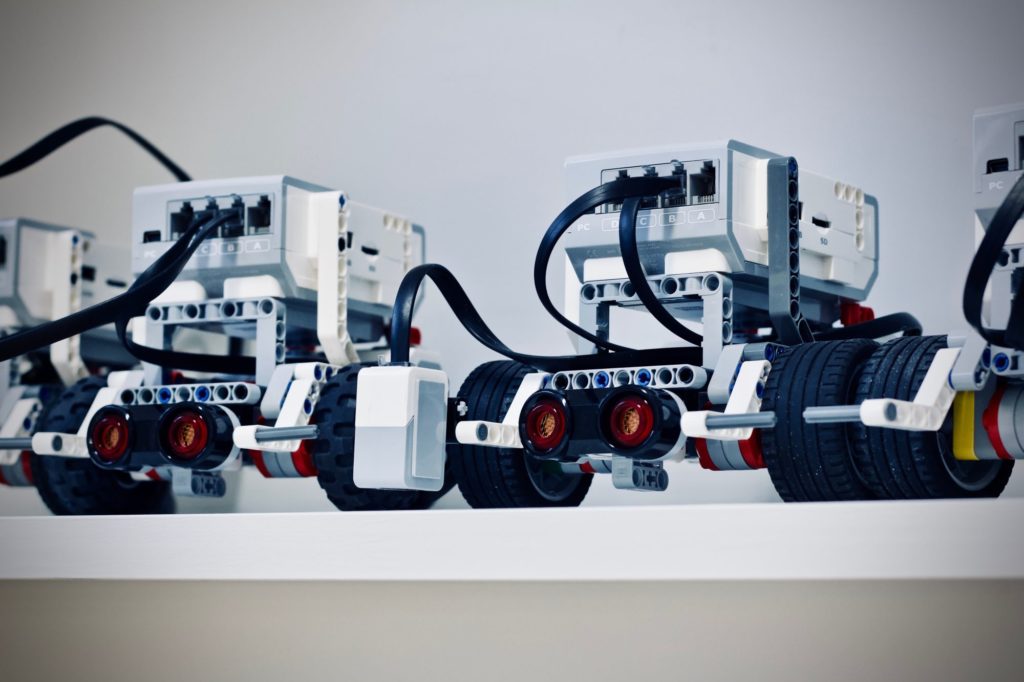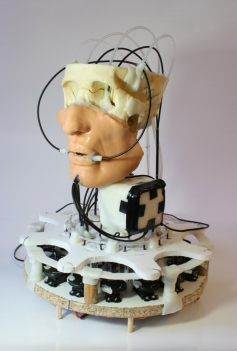
PCT is emerging as a force in robotics. See Rupert Young’s latest video of his presentation at the Science Museum June 2017:https://www.youtube.com/embed/wWSSluTrMrg
Rupert’s pivotal paper on PCT robotics was published in 2017.
PCT lends itself well to the fields of artificial intelligence and robotics because it provides an exact mathematical framework to model psychological processes. Bill Powers explained the benefits of PCT in several key articles in Byte Magazine in 1979. See the quick links menu.
If you want to see PCT in action, then view Richard Kennaway’s online PCT demonstration of a six-legged robot called Archy. Another intriguing example of PCT robotics is Robby the Robot by Walter Fritz.
Another fascinating development has been to use PCT to model human motor control. These models have been described from a theoretical basis (e.g. Powers, 1999). Recently, these have been realised as machines. See Adam Matic’s video of his robot arm that uses visual and pressure sensors:http://www.youtube.com/embed/wQ6FGeSjN9c
In complementary work, Adam Matic has modelled extensor and flexor muscle action using PCT:http://www.youtube.com/embed/TmN99zNRs-4
Roger K Moore has created a simple PCT robot that demonstrates some of the first principles of language development in an online article.
Robot models built using PCT are very simple in design and include few components compared to some of the complex models that try to model specific behaviours rather than using negative feedback to control perception. This suggests that PCT is parsimonious – and may be hitting on what systems are used in nature. For example, in order to grasp an object effectively, it is not necessary for a robot to perceive the shape of the object, as modelled by Rodrigues et al. (1995). In another article, Rodrigues and Lee (1993) describe the simulation of a mobile robot that is capable of learning.
In recent talks at Universities of Sheffield and Manchester, Warren Mansell has summarised some of the emerging work using computer simulations based PCT across the social sciences. Click here for the slides.
Rupert Young’s TAROS talk (2014) is shown in the video below. Rupert has a whole array of PCT robots at his award-winning YouTube site Perceptual Robots.
Increasingly, other researchers are being inspired by PCT in their construction of robots. See the links on the right of this page.http://www.youtube.com/embed/kNv8lA1unJ4
Information Management
Perceptual Control Theory has been utilised in human-computer interfaces to facilitate information management on mobile devices, to enhance security and for impressive hierarchical systems that manage traffic incidents in cities.
Emulating Biological Systems
PCT is grounded in physics and biology. This means that it can be utilised effectively in robotic systems that directly emulate human systems. A pioneering example is the work by Robin Hofe at University of Sheffield on AnTon – the animatronic tongue and vocal tract model, illustrated below. Click here to see the New Scientist video. Interesting work on the pivotal role of sensory processing in prosthetic hands is highly consistent with PCT.

An original take on how biology may inform the future of robotics is provided in the following talk – Warren Mansell contrasts Alan Turing’s approach to artificial intelligence with that of PCT:https://www.youtube.com/embed/odzbwvFWYt0
Human Factors
It is increasingly important to develop the most safe and efficient ways for people to use computers and other forms of technology. PCT has proved particularly helpful in this regard. One example is the Layered Protocol approach and related work by Martin Taylor, Phillip Farrell and colleagues on human-computer interfaces in helicopters. Others include the use of PCT in an operations room for military ships (Chow et al., 2007), in air-traffic control systems (Hendy, 1995) and how to use voice control with machines.
A recent paper by van Erp and colleagues in the Netherlands has used PCT to understand how user systems can anticipate the human user’s intentions and their varying degrees of effort, vigilance, workload and engagement.
Task analysis refers to how we can break down tasks into their parts, so that they can be repeated by people, with minimal error. Rick Marken has developed a way to do task analysis using PCT – called PERCOLATE. It breaks down a task into perceptions to be controlled at different levels. One published example of its use within a mobile context by a Chinese group of researchers is available here
The PCT approach to human factors has also been used to consider applications such as how people relate to their environment (Lulham, 2005), such as human-bulding interaction, and how security can be enhanced in designing environments, such as the design of public buildings (Wise, 2002).

Note: this page was drafted a few years ago on http://pctweb.org/: information needs to be updated. Volunteers welcome.
Quick Links
- Rupert Young; A General Architecture for Robotics Systems: A Perception-Based Approach to Artificial Life. Artif Life 2017; 23 (2): 236–286. doi: https://doi.org/10.1162/ARTL_a_00229
- Perceptual Robots Website
- Franchi, A. M., Mutti, F., & Gini, G. (2016). From learning to new goal generation in a bioinspired robotic setup. Robotics and Autonomous Systems, 79, 795-805. https://doi.org/10.1080/01691864.2016.1172732
- Farrell, P. S. E., & Chéry, S. (1998). PTA: Perceptual Control Theory Based Task Analysis. Behavior Modification, 42(18). https://doi.org/10.1177/154193129804201808
- Richard Kennaway´s demonstration of a multi-legged robot “Archy”
- Archy as a real robot



